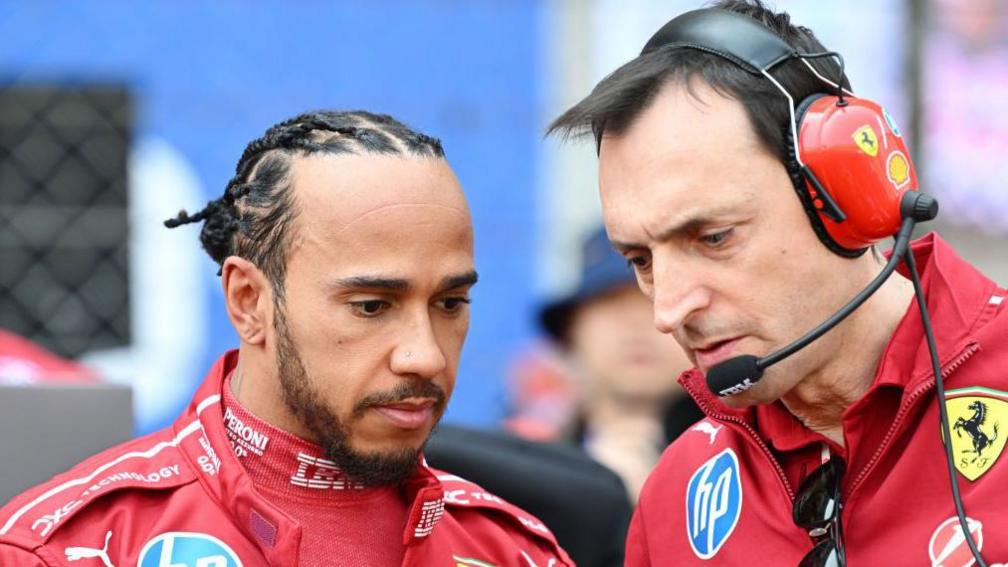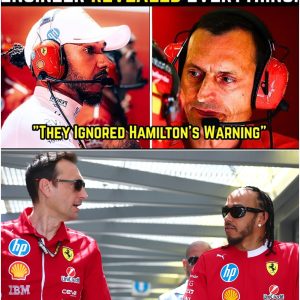Formula 1 is a sport defined by minute details, where even the smallest tweaks can lead to massive gains or losses on the track. As we prepare for the Zandvoort Grand Prix, one of the most challenging and historic circuits on the F1 calendar, there’s talk of a significant yet subtle engine improvement that could make all the difference.
Lewis Hamilton’s arrival at Zandvoort has sparked rumors about a power unit upgrade that’s less about raw horsepower and more about intelligent power delivery. This shift in focus has been publicly framed by Ricardo Adami, Ferrari’s race engineer, as a “sharper, smarter power delivery,” designed to unlock speed exactly where the track demands it most.
The Zandvoort circuit, with its tight corners, banked turns, and punishing nature, offers a unique opportunity to test this nuanced engine enhancement.
But with F1’s strict regulations, particularly the engine freeze that’s been in place since 2022, how can Ferrari legally find performance? Let’s dive into the intricacies of this power unit improvement, exploring how small, calculated changes could lead to big gains at a track where precision is everything.

The Engine Freeze: A Limit to Power but a Challenge for Engineers
When most people hear the words “engine improvement” in the context of F1, they think of more horsepower, faster speeds, and bigger power surges down the straights. However, in 2025, things are quite different. The power unit development freeze, which has been in place since 2022, prevents teams from making substantial changes to the core hardware of the engines. This includes the V6 internal combustion engine, turbocharger, MGU (Motor Generator Unit) that recovers heat energy, and other key components of the hybrid system. Any modification to these systems is strictly prohibited until the major rule changes for 2026.
This freeze catches many by surprise, as it means that teams cannot simply bolt on new parts to make their engines faster. So, how do teams push the boundaries of performance? The answer lies in optimizing the software, calibrations, and energy deployment strategies, rather than physical hardware upgrades. While teams can focus on improving reliability—ensuring that their engine operates smoothly under the most demanding conditions—they can also refine the software maps that control how the engine and hybrid system interact, which is where Ferrari’s improvement comes into play.
The Power of Software and Calibration
Rather than introducing a new engine or drastically changing its hardware, Ferrari’s upgrades focus on refining the software that governs how the engine operates. This involves fine-tuning the hybrid system’s ability to harvest and deploy energy, especially the delicate balance between the internal combustion engine (ICE) and the MGU-K, which recovers energy during braking. For Zandvoort, which is known for its high-speed, long corners and short straights, Ferrari has likely made adjustments to the torque delivery, making it smoother, more predictable, and better suited to the demands of the circuit.
Torque shaping, a key aspect of this improvement, involves ensuring that the power delivery is not too abrupt, especially in corners where the load on the car is constantly shifting. By carefully controlling how and when the hybrid system delivers power, Ferrari can make Hamilton’s car feel more responsive, especially in tricky sections of the track. This allows the driver to carry more speed through critical corners without losing control or battling the car’s unpredictable power delivery.
But that’s not all. Ferrari is also refining the engine braking characteristics. Zandvoort’s banked corners, like Turn 3 (Hugenholtz) and the final corner leading onto the straight, demand that drivers manage their throttle inputs with absolute precision. Any sudden surge of power or unexpected wheel spin could send the car into the gravel. By improving the braking maps and fine-tuning the throttle response, Ferrari can help Hamilton trust the car more, even in those high-pressure, high-speed sections of the track.

Zandvoort: The Ultimate Test Track
What makes Zandvoort such an ideal place to test these subtle engine improvements? The track itself is a beast, known for its old-school, punishing layout. With its steeply banked corners and narrow, winding straights, Zandvoort places a premium on precision. Any minor imbalance in the car’s setup or power delivery can quickly escalate into a major issue. This is why Ferrari’s focus on torque shaping, smoother deployment maps, and more predictable energy harvesting is so crucial.
One of the most challenging aspects of Zandvoort is the banked corners. These corners place a huge amount of vertical and lateral load on the car, tempting drivers to take higher lines to carry more speed. However, this can be dangerous if the car’s power delivery isn’t perfectly smooth. Any surge of power in these corners could unsettle the car, leading to a loss of grip and potentially sending the driver into the gravel. By adjusting the engine map to ensure that the power delivery is both sharp and predictable, Ferrari is giving Hamilton the confidence to attack these high-speed corners with greater precision, ultimately gaining time where others might struggle.
The Role of Hybrid System Optimization
Another key area where Ferrari can find performance without changing the hardware is in the management of the hybrid system itself. Zandvoort’s short straights and long, loaded corners mean that traditional power deployment strategies might not be the most effective. By rebalancing where the car harvests and deploys energy, Ferrari can create a more efficient hybrid system that optimizes the car’s performance at exactly the right moments.
In practice, this means that the car can store energy during braking in the long, sustained corners, then release it strategically during the short straights and crucial overtaking zones. This ability to deploy energy at just the right time is vital at Zandvoort, where passing opportunities are limited, and track position is key. With a more precise deployment map, Hamilton could gain a few crucial kilometers per hour, allowing him to attack the car ahead into Turn 1 or force a mistake from a rival.

Strategy in Code: A New Era of Engine Improvement
In essence, this Ferrari engine upgrade is not about adding raw horsepower; it’s about smarter energy deployment, more precise power delivery, and better thermal management. These subtle changes, combined with improved reliability and a more predictable power unit, could give Hamilton the edge he needs to perform at his best in the tricky conditions of Zandvoort.
Hamilton’s confidence in the car’s performance will be crucial, especially during qualifying, where any advantage in terms of energy deployment and torque delivery can translate into valuable tenths of a second. The ability to consistently harvest and deploy energy without overheating or triggering a power cut will be key to securing a strong grid position. With Zandvoort’s notoriously difficult overtaking opportunities, qualifying could very well determine the outcome of the race.
The Human Element: Hamilton and Adami’s Crucial Partnership
While the technical upgrades to the engine are undoubtedly significant, the driver-engineer relationship also plays a crucial role. Hamilton and Adami must communicate effectively, understanding each other’s needs and making real-time adjustments based on the ever-changing conditions on track. This requires not only a deep technical understanding but also a shared language and trust between the driver and engineer.
As the race progresses, it’s the small, consistent improvements in tire management, energy deployment, and thermal control that will make the difference. Hamilton’s ability to extract the maximum performance from the car without overdriving will be vital, especially in the high-stress environment of a race at Zandvoort.
Conclusion: Invisible Gains in a Visible Sport
In the modern era of Formula 1, the most significant performance gains often aren’t the most obvious ones. As teams like Ferrari continue to innovate with software, energy deployment strategies, and engine reliability updates, the true test of success will be in how well these invisible gains translate into tangible performance on track. For fans watching the Zandvoort Grand Prix, the key to spotting these subtle improvements will lie in looking for signs of smoother power delivery, better tire management, and smarter energy deployment at critical points during the race. While the stopwatch may not show dramatic changes in engine power, the effects of these refinements could make all the difference in securing a victory at one of F1’s most demanding tracks.





